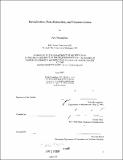| dc.contributor.advisor | George Stiny. | en_US |
| dc.contributor.author | Park, Hyoung-June | en_US |
| dc.contributor.other | Massachusetts Institute of Technology. Dept. of Architecture. | en_US |
| dc.date.accessioned | 2012-02-29T17:22:58Z | |
| dc.date.available | 2012-02-29T17:22:58Z | |
| dc.date.copyright | 1997 | en_US |
| dc.date.issued | 1997 | en_US |
| dc.identifier.uri | http://hdl.handle.net/1721.1/69376 | |
| dc.description | Thesis (M.S.)--Massachusetts Institute of Technology, Dept. of Architecture, 1997. | en_US |
| dc.description | Includes bibliographical references (leaves 109-111). | en_US |
| dc.description.abstract | Shape Grammar introduces the algorithm that stimulates the development of form and its meaning in the design process. Since Shape Grammar provides a way of representing form and its meaning as sets of mathematical terms, which are shapes and the different algebra, Shape Grammar has been anticipated for developing an architect's design idea with a computer-aided system. However, its application has been limited in the theoretical analysis of the historical precedents in architecture. Thus, a study of the practical application of Shape Grammar is needed in order to make creative design, in the actual design process, using a CAD system, possible. Through the experimentation with "making follY," this thesis introduces a model for the application of Shape Grammar to the architectural design process. It presents theoretical foundations, describes the methods of formalization, data abstraction, and communication with Shape Grammar in making designs, and illustrates the process of making folly as the result of this thesis. The approach is derived from the study of the different definitions of architectural form and the observation that architects explore formal ideas by producing sequences of drawings, which are schema(s). This thesis investigates possible methods of formalization and data-abstraction based upon schema(s) in the architectural design. Also, this thesis proposes the framework for a prototype computer system that efficiently supports the communication between different computational tools. This communication is established by encoding the design process as the result of the data abstraction, which is composed of shapes as mathematical means, and formalizing the architect's design knowledge according to certain compositional rules. Then, an experiment with "Folly"l design is performed, based upon the suggested methods for the application of Shape Grammar. In conclusion, based upon the results of the experimentation, the initial territory, spatial block, and spatial components in the combination between different algebra are proposed as design methods for the application of Shape Grammar in the making of a creative design. Also, existing problems in the making of practical software are introduced. | en_US |
| dc.description.statementofresponsibility | by Park, Hyoung-June. | en_US |
| dc.format.extent | 111 leaves | en_US |
| dc.language.iso | eng | en_US |
| dc.publisher | Massachusetts Institute of Technology | en_US |
| dc.rights | M.I.T. theses are protected by
copyright. They may be viewed from this source for any purpose, but
reproduction or distribution in any format is prohibited without written
permission. See provided URL for inquiries about permission. | en_US |
| dc.rights.uri | http://dspace.mit.edu/handle/1721.1/7582 | en_US |
| dc.subject | Architecture. | en_US |
| dc.title | Formalization, data abstraction, and communication | en_US |
| dc.type | Thesis | en_US |
| dc.description.degree | M.S. | en_US |
| dc.contributor.department | Massachusetts Institute of Technology. Department of Architecture | |
| dc.identifier.oclc | 37554089 | en_US |
